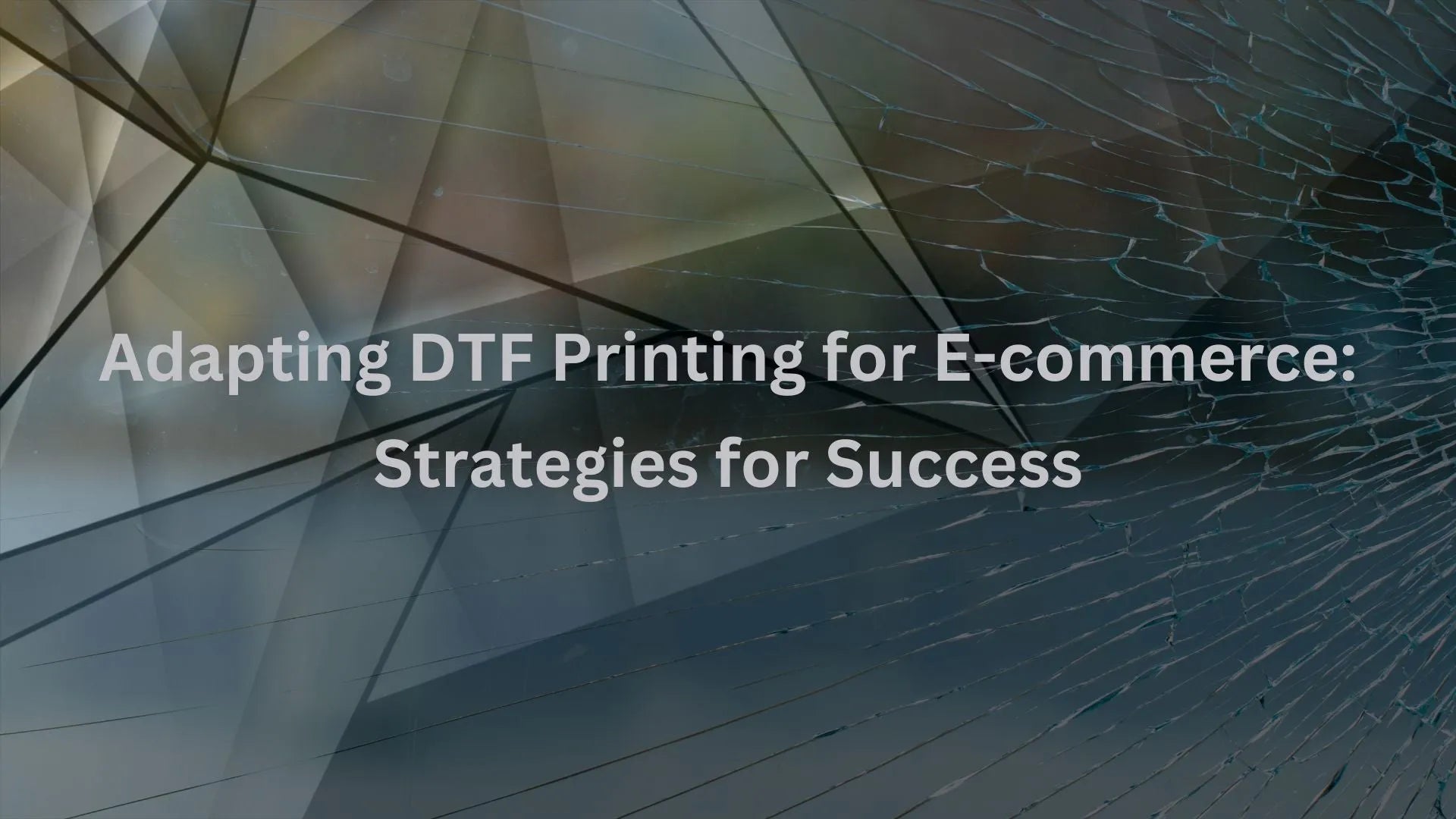
What Materials Can Apply DTF Transfers To?
What Materials Can Apply DTF Transfers To?
The evolution of apparel customization has taken a significant leap with the advent of DTF transfers. Not only has this innovation opened a gateway to limitless creativity for designers and custom apparel businesses, but it has also provided a straightforward solution for adorning a wide array of materials with vivid, long-lasting designs. In this introduction, we will explore the foundational aspects of DTF transfers, distinguish how they set themselves apart from traditional methods like direct-to-garment printing, and elaborate on their compatibility with various fabrics using mediums like printable heat transfer vinyl, sublimation blanks, and inkjet transfer papers. Gain insights into the process that has revolutionized textile embellishment and understand why DTF transfers are swiftly becoming the go-to choice for high-quality apparel customization.
The Versatility of DTF Transfers in Apparel Customization
DTF transfers have revolutionized the apparel industry by offering a flexible, reliable method for printing on various types of fabrics. Whether for professional finish or personal projects, using DTF transfers combined with printable heat transfer vinyl increases the design possibilities.
Fabric Types Suited for DTF Transfers
DTF transfers are exceptionally adaptable, making them ideal for a wide range of fabric types. These include traditional cotton, polyester blends, and even challenging materials like nylon. This versatility is enhanced by the use of advanced design software, allowing precise adjustments that accommodate different fabric characteristics.
Comparing DTF to Traditional Printing Methods
When compared to methods like screen printing and direct-to-garment printing, DTF transfers stand out for their color vibrancy and detail clarity. One major advantage is the ability to produce small batches cost-effectively, a limitation often faced with traditional screen printing due to setup costs.
Benefits of Using DTF for Clothing Items
The benefits of using DTF transfers for clothing are extensive. Primarily, the technique supports intricate designs that hold up under washes and wear, critical for maintaining long-term aesthetic appeal. Tools such as vinyl cutters play a crucial role in ensuring that designs are perfectly cut and ready for transfer, enhancing the overall quality of the final product. Utilizing efficient design software further streamlines production from initial concept to final print, ensuring precision and reducing material wastage.
In summary, embracing DTF technology and its accompanying tools like printable heat transfer vinyl, vinyl cutters, and intuitive design software can dramatically enhance the apparel customization process, providing durability, design versatility, and economic viability.
An Overview of DTF Transfers and Its Compatibility
The rising popularity of DTF transfers in the apparel industry owes much to their broad compatibility with various materials. These transfers, powered by advanced technological inputs, enhance the quality and vibrancy of apparel designs. In this section, we explore how DTF transfers, printable heat transfer vinyl, sublimation blanks, and heat press machines work together to create high-quality wearable art.
- DTF Transfers: Known for their durability and color richness, DTF transfers apply beautifully to a wide range of fabrics. Their ease of use and efficiency make them a top choice for both small businesses and large-scale operations.
- Printable Heat Transfer Vinyl: This material is essential for carrying the ink and design onto your fabric. It accommodates complex color schemes and detailed designs with ease, ensuring every nuance of the original artwork is represented on the final product.
- Sublimation Blanks: These specially coated materials are perfect for DTF applications, ensuring that colors pop and stay vibrant even after multiple washes. Sublimation blanks often come in forms such as t-shirts, mugs, and hats, which are popular items for customization.
- Heat Press Machines: The final step in the DTF transfer process involves a heat press machine, which is used to permanently adhere the printed design onto the material. The right heat press machine can mean the difference between a vibrant, long-lasting design and one that fades or cracks over time.
Heat press machines play a pivotal role in ensuring that the transfers are properly adhered, handling the necessary heat and pressure settings that different materials demand. Optimizing the temperature and timing is crucial to avoid damaging the integrity of both the material and the design.
The beauty of DTF transfers lies in their versatility, catering to a diverse range of materials and products, amplifying the creative possibilities in the realm of apparel and accessory customization.
In conclusion, the integration of DTF transfers, printable heat transfer vinyl, and sublimation blanks with the reliable operation of heat press machines creates a robust system for producing durable and visually appealing custom apparel. This compatibility not only enhances the aesthetic qualities of the products but also heightens the efficiency and scalability of apparel production.
Materials Suited for DTF Transfer Application
As the textile industry evolves, so do the technologies that enhance fabric customization. DTF transfers are leading this change, providing vibrant and durable designs on a variety of textiles. Key materials include cotton, polyester, and stretchable fabrics, each offering unique benefits when paired with DTF technology.
Cotton and Cotton Blends
Cotton, renowned for its comfort and breathability, proves to be an excellent base for DTF transfers. The natural fibers absorb ink well, resulting in crisp, vibrant transfers. Cotton blends, which mix cotton with synthetic fibers, also maintain these qualities while often adding durability. The use of heat press machines ensures that the transfer adheres firmly to the fabric, enhancing longevity and wearability.
Polyester and Stretchable Fabrics
Polyester and fabrics with elasticity are ubiquitous in sportswear and casual attire due to their stretch and resilience. DTF transfers align well with these materials, adhering smoothly even under stretch. The elastic nature of these fabrics requires precise heat settings from heat press machines, which activate the transfer's adhesive layer without damaging the fabric. This flexibility makes polyester and stretchable fabrics ideal for dynamic or form-fitting designs.
Specialty Fabrics and Materials
Beyond conventional textiles, DTF transfers are also applicable to specialized materials that diverge from everyday fabric types. These include heavily textured fabrics or those with special coatings that may require specific adjustments in the application process. Professionals often utilize inkjet transfer papers designed to cope with such diverse materials, ensuring that every DTF transfer maintains its color fidelity and durability.
Choosing the right material for DTF transfers not only ensures a high-quality finish but also expands creative possibilities. Whether applying to a delicate cotton scarf or a robust polyester jersey, the combination of appropriate materials, inkjet transfer papers, and reliable heat press machines plays a pivotal role in achieving superior results.
Understanding the DTF Transfer Process
The journey of creating custom apparel through DTF transfers is intriguing and full of potential for both new and experienced designers alike. This process not only highlights the effectiveness of using printable heat transfer vinyl, but it also showcases how design software and heat press machines play critical roles in apparel customization.
Initially, the design phase begins with robust design software, where creativity is unleashed. The software allows for precise adjustments and modifications to ensure that the final product will meet customer expectations. After the design is finalized, it is printed onto high-quality printable heat transfer vinyl. This material is chosen for its durability and its ability to hold vibrant colors that last.
The process from digital design to physical product exemplifies the flexibility and innovative possibilities of DTF transfers, offering endless opportunities to customize apparel.
Following the printing phase, the next step involves curing the printed vinyl. Curing is crucial as it sets the ink, making the design ready for the final application. The culmination of the process is where heat press machines come into play. These machines are essential for applying consistent heat and pressure, ensuring that the transfer permanently adheres to the fabric, resulting in a smooth, professional finish.
- Design Software: Start with detailed design preparation.
- Printable Heat Transfer Vinyl: Print your designs onto selected vinyl.
- Curing: Ensure the ink sets properly on the vinyl.
- Heat Press Machines: Apply the design to your apparel under precise temperature and pressure.
Through each stage, the essence of apparel customization is maintained, providing personalized results that stand out. The entire DTF transfer process not only simplifies custom garment creation but also enhances the quality and appeal of the finished product.
Key Equipment: Heat Press Machines and Vinyl Cutters
In the dynamic world of apparel customization, DTF transfers stand out for their vibrant results and adhesion on a diverse range of materials. A crucial part of achieving that professional level of quality lies in the equipment used. Heat press machines and vinyl cutters are at the core of this process, each playing a pivotal role in delivering the crisp, colorful designs that DTF transfers are known for.
Selecting the Right Heat Press for DTF Transfers
When it comes to DTF transfers, the heat press machine is an indispensable tool. Effective transfer of the printed designs onto apparel or sublimation blanks rests heavily on selecting a heat press that provides consistent temperature and pressure across its plate. Size also matters: the plate needs to accommodate the range of products you intend to customize. Understanding these specifications is vital to ensure not only that the DTF transfers adhere properly but also that their longevity and washability meet customer expectations.
The Role of Vinyl Cutters in Preparing Transfers
Meanwhile, vinyl cutters play a significant role in refining the custom designs before they ever reach the heat press. These devices offer precision cuts for the DTF transfers, ensuring that each design is sharp and ready for application. Their use streamlines the entire printing process, setting them apart from traditional methods like direct-to-garment printing. Vinyl cutters are especially advantageous when working with intricate patterns or when needing to batch produce designs on inkjet transfer papers for later use.
To conclude, the technology behind DTF transfers evolves with the apparel industry, requiring the best from equipment like heat press machines and vinyl cutters. These tools work synergistically to produce high-quality, durable designs on a wide array of materials, paving the way for innovation and creativity in apparel customization. As the demand for personalized apparel grows, understanding and investing in the right equipment becomes increasingly integral to success in the world of DTF transfers.


Leave a comment
This site is protected by hCaptcha and the hCaptcha Privacy Policy and Terms of Service apply.